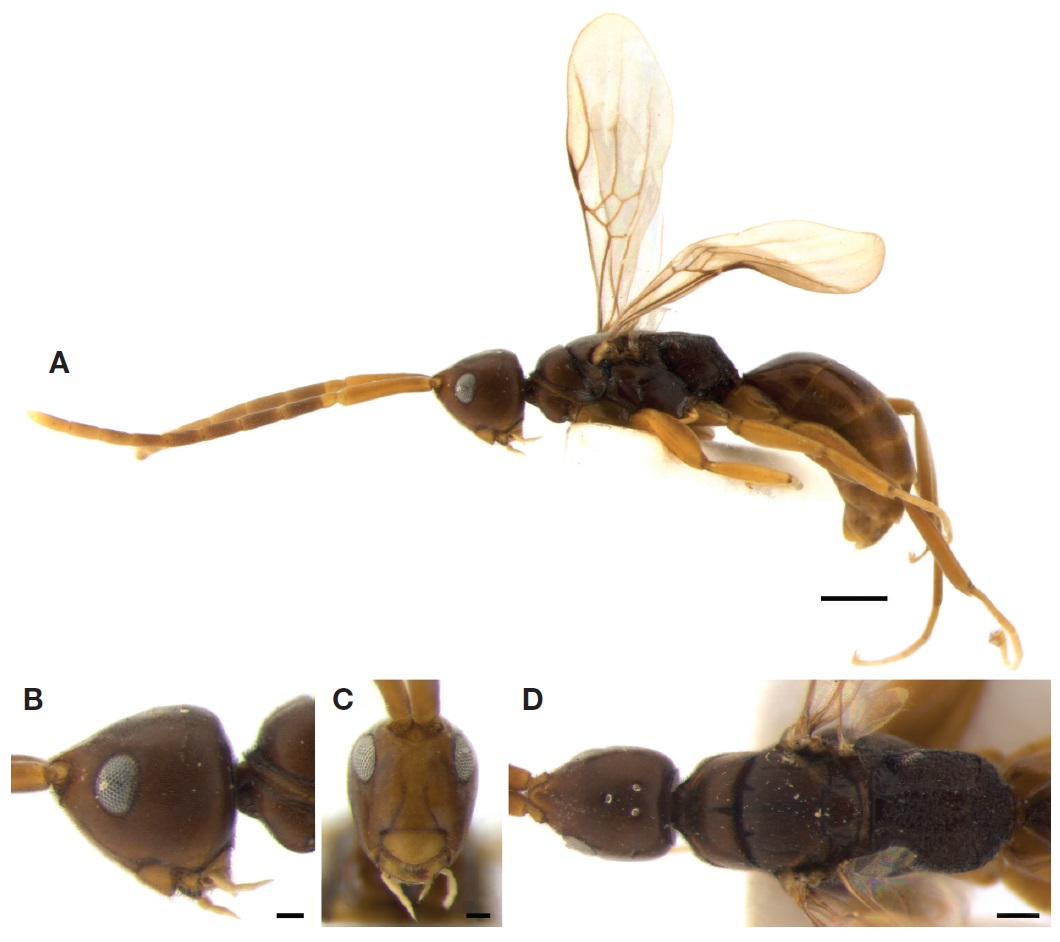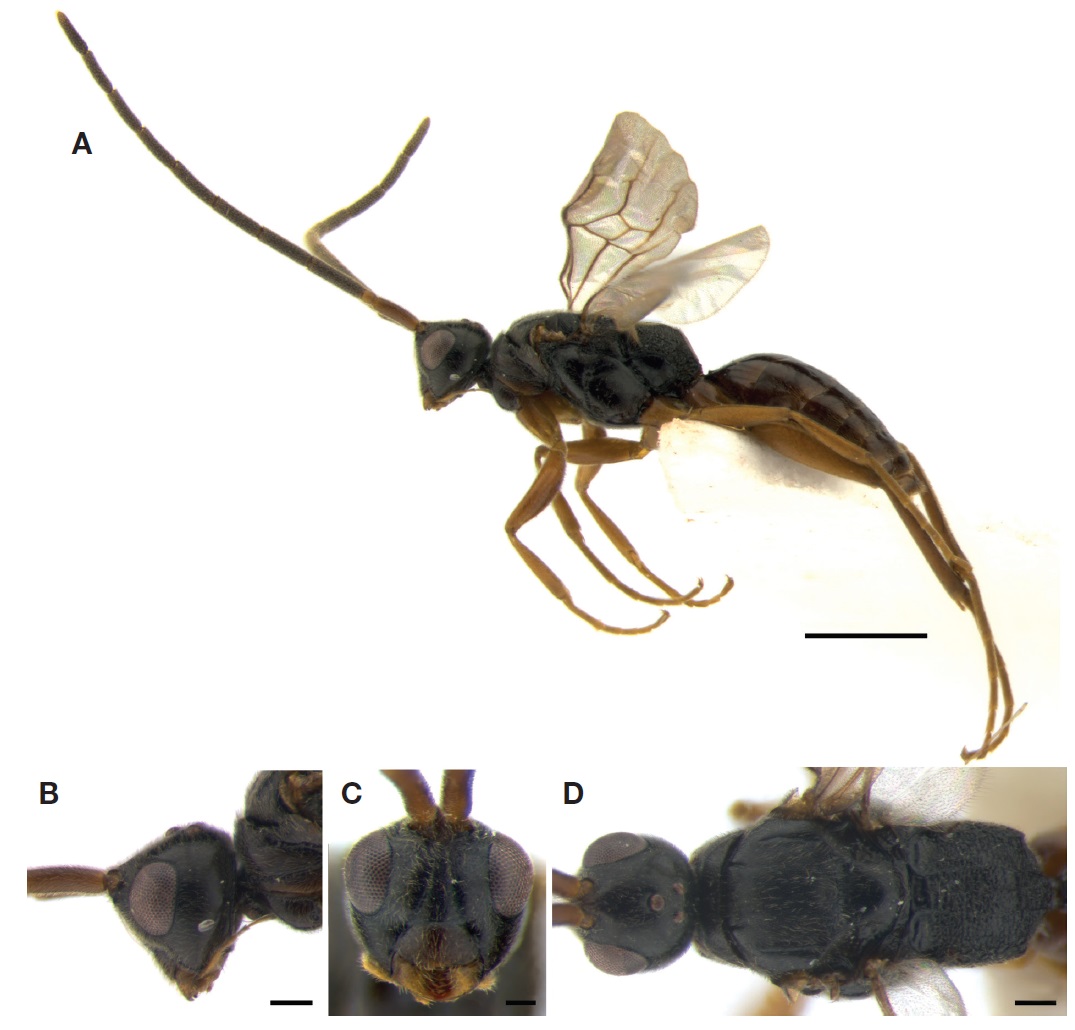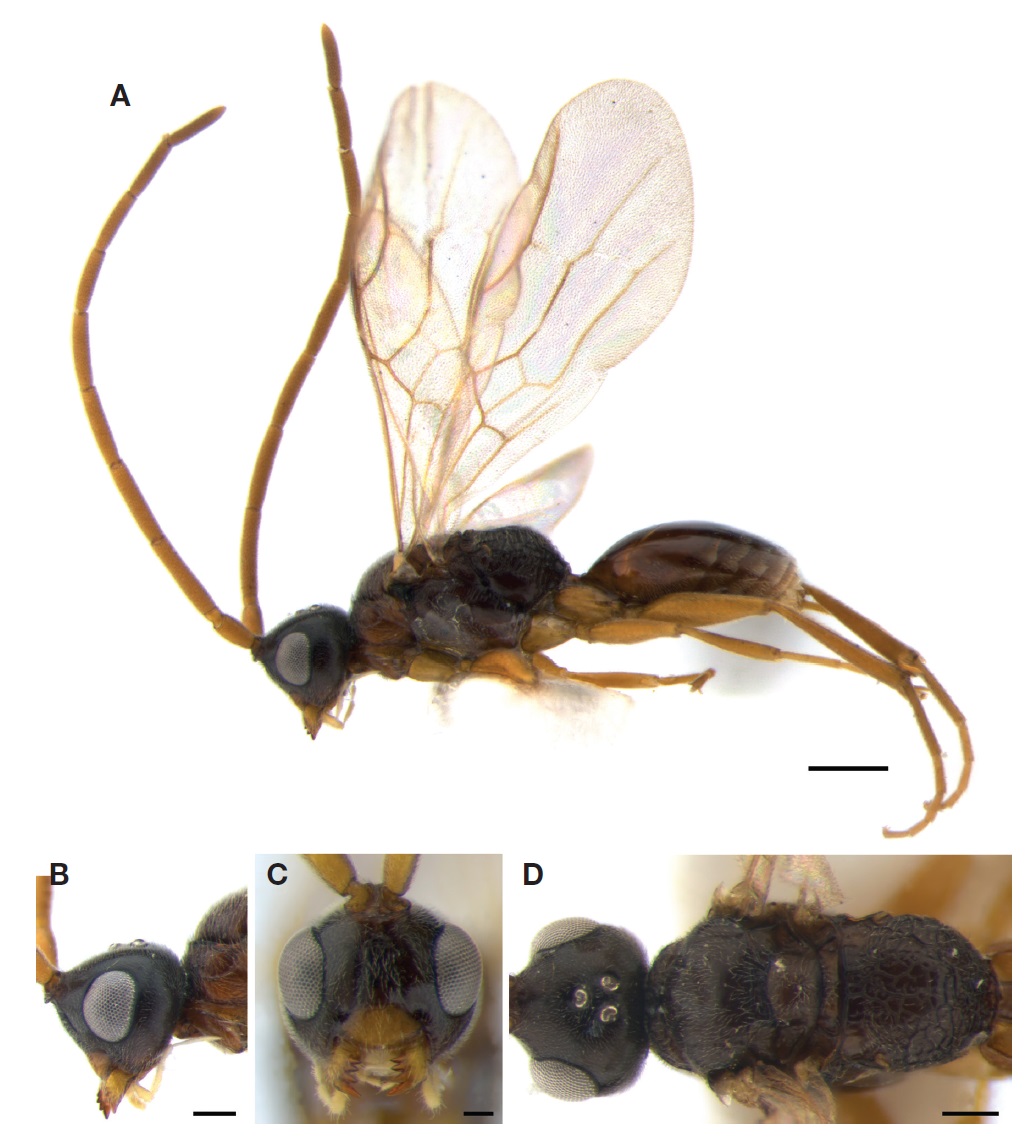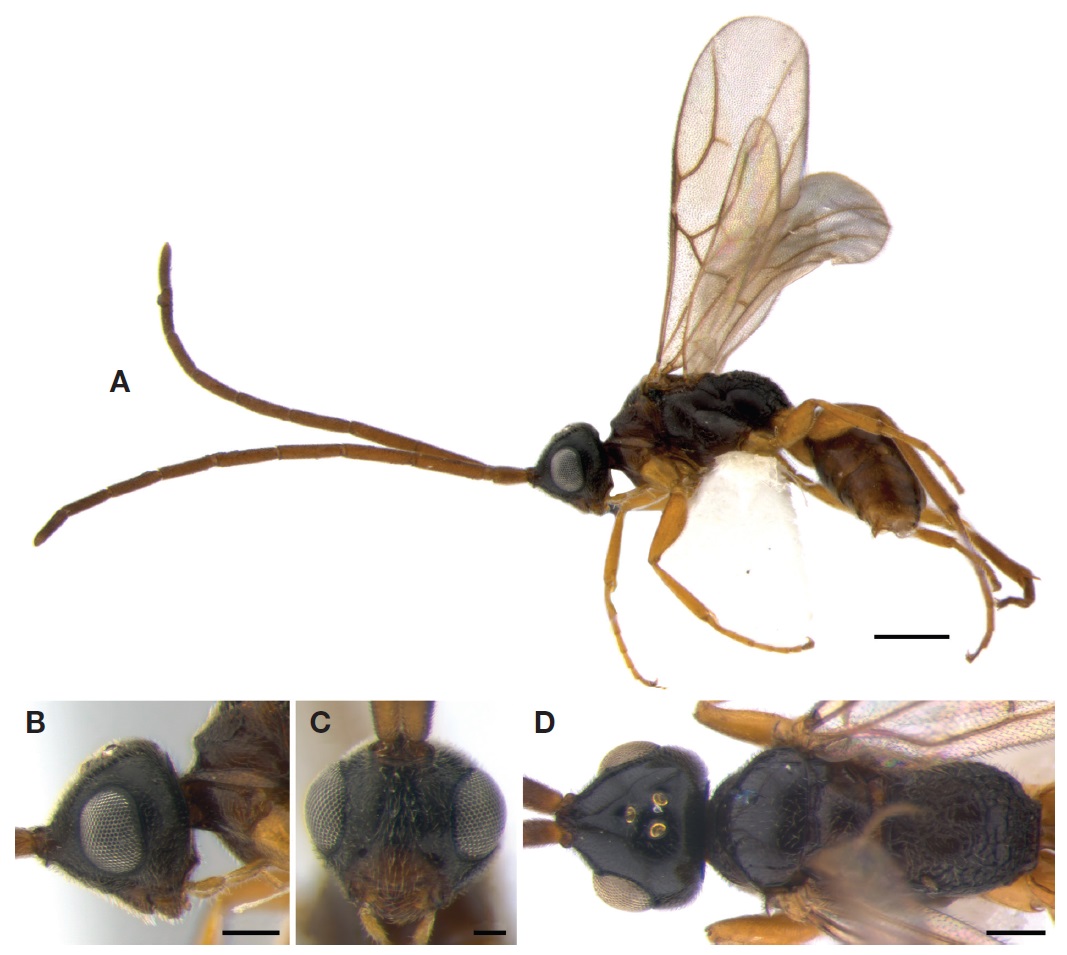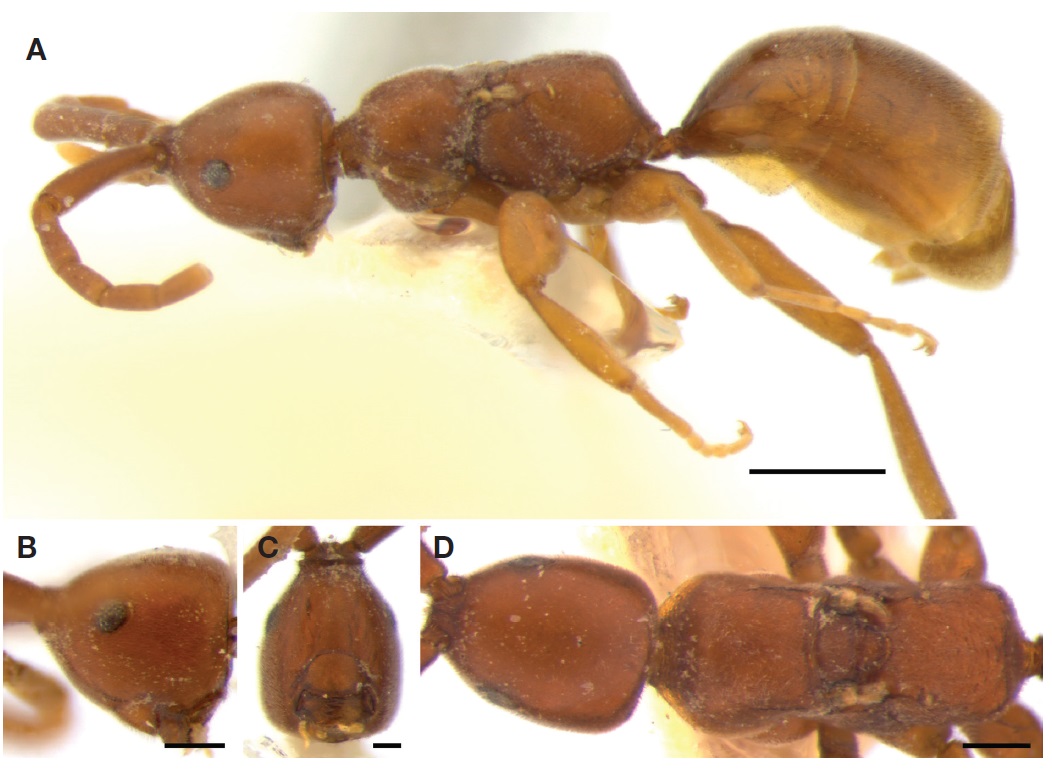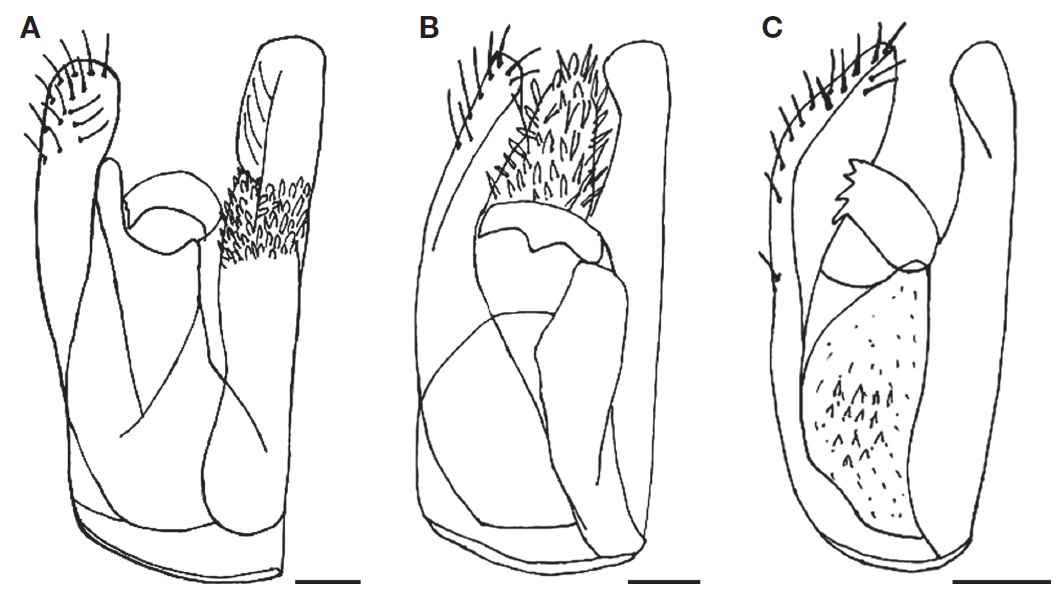



Previously only one species, Embolemus ruddii Westwood, 1833, of the family Embolemidae has been recorded in South Korea. As part of a recent study of this family, we newly report four species from South Korea: Embolemus hachijoensis
Embolemidae Förster, 1856, one of the families within the superfamily Chrysidoidea, consists of 106 valid species distributed in three valid genera of the world:
As natural enemies, members of the Embolemidae are known to be parasitoids of the nymphs of planthoppers (Hemiptera: Auchenorrhyncha):
Previously only one species,
The morphological terms used in the present study follow Olmi (1994, 1996, 1999). The images were captured with an Axiocam HRc camera through a Discovery V20 stereomicroscope and produced with the AxioVision40AC software (Carl Zeiss, Oberkochen, Germany). Final plates of illustrations were prepared in Adobe Photoshop CS6.
Abbreviations are as follows: BMNH, The Natural History Museum, London, UK; OL, distance between the inner edges of a lateral ocellus and the median ocellus; OOL, distance from the outer edge of a lateral ocellus to the compound eye; OPL, distance from the posterior edge of a lateral ocellus to the occipital carina; POL, distance between the inner edges of two lateral ocelli; TL, distance from the posterior edge of an eye to the occipital carina; BC, basal cell; CC, costal cell; SBC, sub-basal cell; 1DC, first discal cell; 1SDC, first subdiscal cell; MT, Malaise Trap; PT, Pitfall Trap; YPT, Yellow Pan Trap.
The material studied in the present paper is deposited at the Yeungnam University (YNU), Gyeongsan, South Korea.
Type species.
Diagnosis. Macropterous; fore wing usually with 1SDC cell fully enclosed by pigmented veins (or partly open); palpal formula 6/3, 6/2, or 5/2; tibial spurs 1/2/2; female antennal segment 1 much longer than segment 3; male antennal segment 1 usually shorter than segment 3.
>
Material examined. South Korea: 1♀, Gyeongsangbuk-do: Gyeongsan-si, Dae-dong, Yeungnam Univ., 35°58′N, 128°47′ E, 12-21 Jul 2007 (MT), Lee JW leg. (YNU); 1♀, Cheongdo-gun, Gakbuk-myeon, Namsan-ri, 35°38′N, 128°47′E, 5-29 Jul 2010 (MT), Lee JW leg. (YNU); 1♀, ditto, 20 Jun-3 Jul 2011(MT), Lee JW leg. (YNU); 1♀, Cheongsong-gun, Mt. Juwangsan, Jusanji, 6 Sep-13 Oct 2008 (MT), Jeong JC leg. (YNU).
Diagnosis of female. Body length 3.72-4.34 mm. Macropterous. Head, mesosoma and metasoma dark brown except propodeum and metapleuron blackish brown; mandible, antenna, legs yellowish brown to brown. Antennal segments in following proportions: 30 : 8 : 18 : 18 : 18 : 18 : 16 : 15 : 15 : 19. Head dull, covered with short hairs; occipital carina complete; POL: 3; OL: 4; OOL: 9; OPL: 5; TL: 13; eye very small, approximately 0.29 times as long as head (17 : 58); region of face from clypeus to antennal toruli with two very convergent longitudinal and median sutures visible (upper half of sutures hardly visible). Pronotum dull, covered with short hairs and complete median longitudinal furrow. Notauli absent. Parapsidal lines distinctly visible near lateral margins of scutum. Propodeum dull, reticulate rugose, with two median longitudinal keels from anterior margin to posterior surface. Fore wing hyaline, without dark transverse bands; 1SDC cell partly open, not fully enclosed by pigmented veins.
Male. Unknown.
Host. Unknown.
Distribution. South Korea (new record), Russia (European).
Type species.
Diagnosis. Female: Usually micropterous, occasionally brachypterous; head pyriform; maxillary palpus with 3-5 segments; labial palpus with two segments; ocelli absent; pronotum without or with trace of a median furrow. Male: Fully winged; fore wing usually with costal, basal, subbasal and first discal cells fully enclosed by pigmented veins; first subdiscal cell not fully enclosed by pigmented veins, partly open; head not pyriform; pronotum without or with trace of a median longitudinal furrow; maxillary palpus with 3-6 segments; labial palpus with 2-3 segments. Ocelli distinct.
>
Material examined. South Korea: 1♂, Gangwon-do: Donghae-si, Samhwa-dong, Mureung valley, 11-21 Jul 2006 (MT), Lee JW leg. (YNU); 1♂, Gyeonggi-do: Osan-si, Geumamdong, Mulhyanggi Arboretum, Alt. 38 m, 37°10′3.1″N, 127°03′24.2″E, 16 Apr-31 Aug 2012 (MT), Kwon YD, Ji YM (YNU); 1♂, Gyeongsangbuk-do: Gyeongsan-si, Dae-dong, Yeungnam Univ., 35°58′N, 128°47′E, 1-24 Mar 2012 (MT), Lee JW leg. (YNU); 1♂, Kyeongju-si, Hyeongok-myeon, Namsa-ri, 15-29 Sep 2005 (MT), Mun JT leg. (YNU); 1♂, Jeju-si, Ara-1-dong, Jeju Univ., 4-11 Nov 2008 (MT), Lee JW leg. (YNU).
Diagnosis of male. Body length 1.90-3.20 mm. Macropterous. Head, mesosoma and metasoma brown or dark brown; antenna brown, except segments 1-2 yellow, or dark brown, except segments 1-2 brown; clypeus, mandible, legs yellow or yellowish brown. Antennal segments in following proportions: 32 : 8 : 41 : 38 : 36 : 36 : 32 : 32 : 30 : 38. Head dull, covered with short hairs; occipital carina complete; POL: 13; OL: 12; OOL: 28; OPL: 20; TL: 40; eye small, approximately 0.46 times as long as head (21 : 45); region of face from clypeus to antennal toruli with two distinct longitudinal and median sutures. Pronotum dull, without track of median longitudinal furrow. Notauli incomplete, hardly visible near anterior margin of scutum. Parapsidal lines distinctly visible near lateral margins of scutum. Propodeum dull, reticulate rugose, with two median longitudinal keels from anterior margin to posterior surface. Fore wing hyaline, without dark transverse bands; 1SDC cell almost completely enclosed by pigmented veins or partly open, not fully enclosed by pigmented veins. Dorsal membranous process of paramere with mosaic drawing, without papillae.
Female. Unknown.
Host. Unknown.
Distribution. South Korea (new record), Japan.
>
Material examined. South Korea: 2♂♂, Gyeonggi-do: Namyangju-si, Choan, Songchon, Mt. Ungilsan, 37°34′43.2″N, 127°18′40.1″E, 19 Sep-15 Oct 2009 (MT), Lim JO leg. (YNU).
Diagnosis of male. Body length 3.18-3.67 mm. Macropterous. Head dark brown except clypeus and mandible yellowish brown; mesosoma and metasoma brown; antenna and legs yellowish brown. Antennal segments in following proportions: 20 : 6 : 45 : 45 : 40 : 39 : 34 : 35 : 32 : 35. Head shiny, covered with short hairs; occipital carina complete; POL: 5; OL: 6; OOL: 14; OPL: 12; TL: 16; eye small, approximately 0.40 times as long as head (21 : 53); region of face from clypeus to antennal toruli with two distinct longitudinal and median sutures. Pronotum very short, partly hidden behind occiput, with complete median longitudinal furrow. Notauli incomplete, reaching approximately 0.20×length of scutum. Parapsidal lines visible near lateral margins of scutum. Propodeum dull, rugose to reticulate rugose, without longitudinal keels. Fore wing hyaline, without dark transverse bands, with four cells fully enclosed by pigmented veins (CC, BC, SBC, 1DC). Proximal membranous process of paramere with numerous papillae on distal region.
Female. Unknown.
Host. Unknown.
Distribution. South Korea (new record), China, Indonesia, Japan, Russia (Far East), Spain, Vietnam.
>
Material examined. South Korea: 2♂♂, Gangwon-do: Donghae-si, Samhwa-dong, Mureung valley, 15 Jul-1 Aug 2005 (MT), Lee JW leg. (YNU); 1♂, Inje-gun, Girin-myeon, Mt. Bantaesan, 27 Aug-26 Sep 2013 (MT), Park JY leg. (YNU); 1♂, Gyeonggi-do: Osan-si, Geumam-dong, Mulhyanggi Arboretum, Alt. 38 m, 37°10′3.1″N, 127°03′24.2″E, 16 Apr-31 Aug 2012 (MT), Kwon YD, Ji YM (YNU); 2♂♂, Nanyangju-si, Choan, Songchon, Mt. Ungilsan, 37°34′43.2″N, 127°18′40.1″E, 26 Jun-16 Jul 2009 (MT), Lim JO leg. (YNU); 1♂, Jeju-do: Seogwipo-si, Namwon-eup, Harye-ri, Hyoryegyo, 33°15′49″N, 126°37′28″E, 7 Aug 2013 (YPT), Kim KB leg. (YNU).
Diagnosis of male. Body length 2.99-3.77 mm. Macropterous. Head dark brown except clypeus and mandible brown; mesosoma and metasoma brown; antenna brown; legs yellowish brown. Antennal segments in following proportions: 18 : 6 : 40 : 38 : 35 : 33 : 31 : 30 : 29 : 32. Head shiny, covered with short hairs; occipital carina complete; POL: 5; OL: 5; OOL: 11; OPL: 10; TL: 12; eye small, approximately 0.46 times as long as head (21 : 46); region of face from clypeus to antennal toruli with two distinct longitudinal and median sutures. Pronotum very short, with complete median longitudinal furrow. Notauli incomplete, reaching approximately 0.35×length of scutum. Parapsidal lines distinctly visible near lateral margins of scutum. Propodeum dull, reticulate rugose, with two median longitudinal keels from anterior margin to posterior surface. Fore wing hyaline, without dark transverse bands; 1SDC cell open. Proximal membranous process of paramere with many sensorial filaments located on distal and subdistal region, without papillae.
Female. Unknown.
Host. Unknown.
Distribution. South Korea (new record), China, Japan, Russia (Far East), Vietnam.
>
Holotype material examined. China: 1♀, Zhejiang, near Ning Po (=Ningbo), Da-Laen-Saen, 1500-2500 ft., 5-16 Nov 1892, with ants, Walker JJ leg. (Cruis of the Penguin) (BMNH).
Other material examined. South Korea: 1♀, Gyeongsangnam-do: Miryang-si, Mijeon-ri, 36°32′06″N, 127°49′40″E, 19 Apr-2 May 2008 (PT), Hong EJ leg. (YNU).
Diagnosis of female. Body length 3.20 mm. Micropterous. Head, mesosoma, metasoma, antenna, legs yellowish brown to brown. Antennal segments in following proportions: 45 : 10 : 18 : 20 : 20 : 18 : 17 : 15 : 15 : 20. Head dull, covered with short hairs; occipital carina complete; ocelli absent; eye very small, approximately 0.19 times as long as head (5 : 26); region of face from clypeus to antennal toruli with two distinct longitudinal and median sutures. Pronotum dull, granulate, covered with short hairs, crossed by strong anterior transverse impression, with two fine lateral incomplete carinae beginning at posterior border and reaching about 0.5× length of pronotum; anterior collar very short; disc long, without median longitudinal groove. Scutum small, subrectangular, granulate. Notauli absent. Parapsidal lines present, hardly visible near lateral margins of scutum. Propodeum with spiracles normally prominent; anterior dorsal surface flat, granulate to weakly rugose; posterior surface granulate with transverse striae; Fore wing strongly reduced, slightly longer than tegula, hind wing absent.
Male. Unknown.
Host. Unknown.
Distribution. China, Japan, South Korea.
Remark. Until now, only one species,
>
Key to the species of South Korean Embolemidae
Females (unknown in the species absent in the key)
Males (unknown in the species not present in the key)
Korean name:1*날개멸구살이벌속, 2*날개멸구살이벌 Korean name:1*멸구살이벌속, 2*민멸구살이벌, 3*돌기멸구살이벌 Korean name:1*수염멸구살이벌 Korean name:1*멸구살이벌
